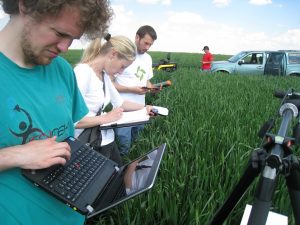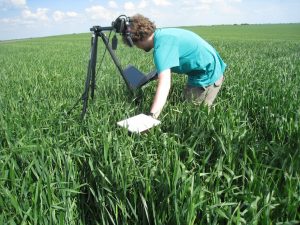Application of NDVI sensors in wheat production and breeding programs
Implementation period: 15/06/2016 - 15/06/2017
GA number: APV - Competition for the realization of the action "Right to the first chance"
Type of Project: National
Project aim: The project “Application of NDVI sensors in wheat production and breeding programs” is dedicated to accelerate the introduction of smart and precise technology in large-scale agricultural production through the adoption of application of sensors, all with the main aim to improve agricultural production and increase yields.
About the project: Regarding to multiple purpose, acceptable application and increasing availability, the application of NDVI sensors is gaining popularity, both in agricultural production and breeding programs. Spectral vegetation indices such as NDVI (Normalized Difference Vegetation Index) represent one of the most promising tools for application in field phenotyping with potential to provide complex information on different traits of wheat. The objective of this study was to evaluate the potential of different NDVIs derived from field reflectance measurements in identification of a specific growth stage in which proximally sensed data showed the highest association with grain yield and yield related traits of wheat. The study was carried out at the field trial on chernozem soil type, on location in Bečej, in Vojvodina, during vegetation seasons of 2015/2016. The experimental material was comprised of winter wheat cultivars (Triticum aestivum L.) widely grown in Serbia and other surrounding countries. The NDVI was determined using an proximal sensor GreenSeeker (NTech Industries Inc., USA) and hyperspectral camera (Ximea Corp., CO USA) at four growth stages of wheat: full flowering, medium milk, early dough and fully ripe. The hyperspectral NDVI indices were calculated from two-band combinations between red (600-700 nm), far-red (700-750 nm) and near-infrared (756-955 nm) regions. The NDVI values were geopositioning and therefore the control of grain yield and yield related traits were performed according to the previously determined spatial distribution of NDVI measurements. At the stage of full maturity, ten plants from each replication of each wheat genotypes were selected and yield and yield related traits were estimated. Spatial variability of yield on the plot is accompanied by the “Yield monitor” mounted on the tractor combine. The results showed that the measured NDVI values in a certain grown stage: (1) can be successfully used in early assessment of biomass, plant height and yield; (2) could provide information on the different nitrogen uptake by plants, by differentiating wheat genotypes based on measured values; (4) may indicate differences in “stay green” wheat genotypes, as stress tolerant genotypes. The overall results indicated that hyperspectral camera provided alternative spectral combinations, for different NDVIs which could be successfully used in assessing plant traits of a large number of wheat genotypes. Besides observing absolute values of NDVI in different growth stages, observing the change in NDVI throughout the stages may be very indicative. The obtained results could contribute to facilitate the introduction and application not only NDVI sensors, but also other segments of precision technology in agricultural practice and large-scale wheat production for the purpose of improvement production technology and increase the yield.



